Laptop Mag Verdict
The Razer Blade Pro retains its sleek design and adds a new, improved Switchblade UI for gamers and creative professionals.
Pros
- +
Slim, sexy design
- +
Innovative secondary screen
- +
Switchblade UI has been expanded to use more creative professional apps
- +
Solid graphics and overall performance
- +
Excellent battery life
Cons
- -
Runs hot when gaming
- -
A tad expensive
Why you can trust Laptop Mag
All work and no play makes Jack a dull boy, but Jack has to work sometime. The 17-inch Razer Blade Pro ($2,399 as tested) retains the stunning good looks and the innovative LCD touchpad of the original, but added several new shortcuts designed for game development, photo and music editing as well as apps to improve your gaming. Throw in an Intel Core i7 CPU, Nvidia's GeForce GTX 860 GPU and more than 6 hours of battery life and you've got a lean, mean gaming machine that can also help you create your next masterpiece.
Design
Razer has left the Blade Pro's design practically unchanged since its debut in 2012. Normally, that would be a cause for concern, but the laptop is just as pretty now as it was then. I mean, who could resist the notebook's sleek black aluminum chassis and that bewitching green tri-snake logo? Not I.
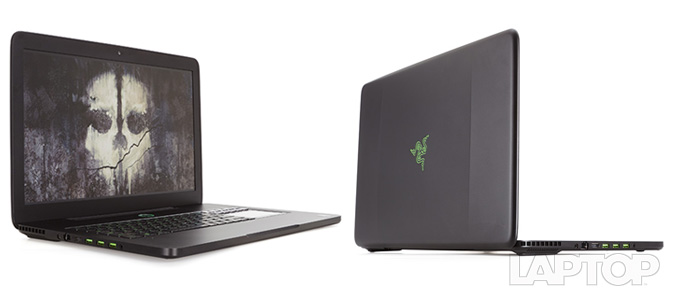
The company also left the laptop's interior unchanged, preserving the large, green and glowing power button at the top of the deck. Above that, you'll find a slim black speaker grille. Directly below is the full-size keyboard, which sits to the left of one of Razer's most innovative designs, the glossy LCD touchpad with its 10 accompanying macro buttons.
At 6.6 pounds, 16.8 x 10.9 x 0.88-inches, Razer has maintained the Blade's waifish figure. It's noticeably lighter and slimmer than the Aorus X7 (7.2 pounds, 16.8 x 12.0 x 0.9 inches), but is thicker and heavier than both the MSI GS70 Stealth Pro (6 pounds, 16.5 x 11.3 x 0.85 inches) and the Maingear Pulse 17 (6.2 pounds, 16.5 x 11.3 x 0.85 inches).
Display
While the smaller Razer Blade 14 has a 3200 x 1800-pixel display, the Pro has a lower-res 1080p panel. The 17.3-inch matte screen delivered vibrant color, but details weren't as sharp as I would have liked.
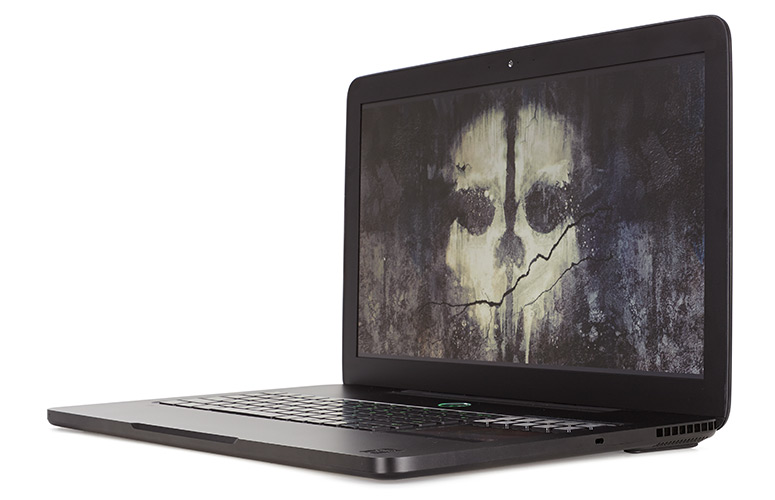
As I watched the 1080p trailer of Selma, my eyes were immediately drawn to Oprah Winfrey's dark red lips. However, when I started taking in the entirety of the scene, I noticed there was a fair amount of visual noise. For instance, the fine markings on the rather large gold button on her cape were hard to make out.
The display gave its best performance when I started playing Far Cry 4. On very high settings, the notebook delivered ethereal plumes of fog topping snow-capped mountains, which gave way to sweeping green plains. The color looked a shade or two darker than I'm used to seeing, but the panel did a good job of capturing details, such as the subtle brown markings set against the inky black fur of a clouded leopard.
MORE: Best Laptops
When tested for its color reproduction capabilities, the Blade Pro delivered 92.9 percent of the sRGB gamut. That's better than the Pulse 17's 89.8 percent, but the X7 scored a higher 102 percent.
Despite the display's vibrancy, I was surprised at the Blade Pro's color accuracy, or lack thereof. The laptop scored 9.2 on the Delta-E test, which is much higher than a perfect score of 0. The Blade Pro was on a par with the Pulse 17's 9.4, but the X7 fared much better with a score of 1.
The Blade Pro is also fairly dim when compared with the competition. At 252 nits, this panel's brightness is lower than the 275-nit desktop replacement average. The Aorus performed somewhat better at 264 nits, while the Maingear shone with a score of 300 nits.
Audio
Despite its slim dimensions, the Razer Blade Pro can make big noise, but I've heard better. Listening to "Bliss" by John Legend and Teyana Taylor, I was enraptured by the electric guitar that filled my medium-size test space.

Legend's vocal was warm and rich, but I noticed that Taylor's sounded slightly distorted at maximum volume. I attempted to fix the scratchiness and the noticeable lack of bass using the Dolby Digital Plus software, to no avail.
The speakers did a great job of conveying the myriad animal calls throughout Far Cry 4. The sound was precise enough that I could easily pinpoint the direction the animal was coming from, which saved me from many a wolf or eagle attack.
MORE: Best Gaming Desktops
However, the speakers still lacked the oomph I was expecting. When I blew up an enemy convoy with an M-79, the sound of the explosive canister leaving the gun's cylinder was clear, but the inevitable explosion sounded distant and hollow.
When measured for volume, the Blade Pro matched the 87 decibel desktop replacement average, besting the X7's 82 dB, but not the Pulse 17's 92 dB.
Keyboard
Like gleaming emeralds encased in tantalizing onyx, the Blade Pro's island-style keyboard is gorgeous.
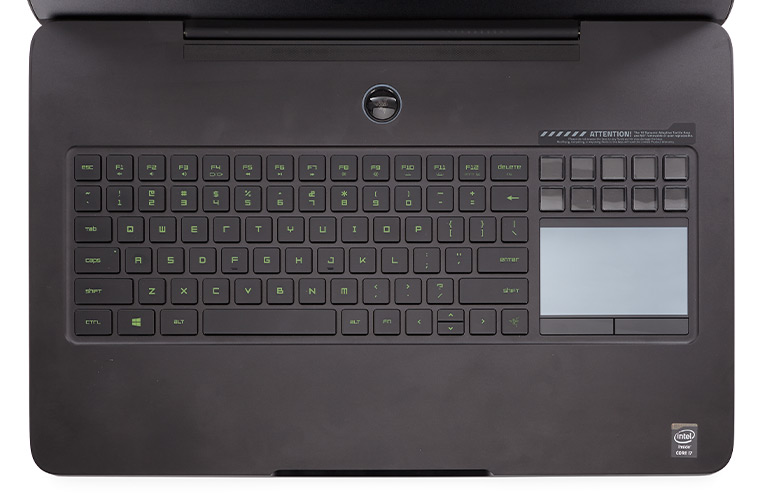
While other gaming laptops allow you to tweak the color of the backlighting, the company holds firm with its signature green and its funky block lettering, creating something that's distinctly Razer.
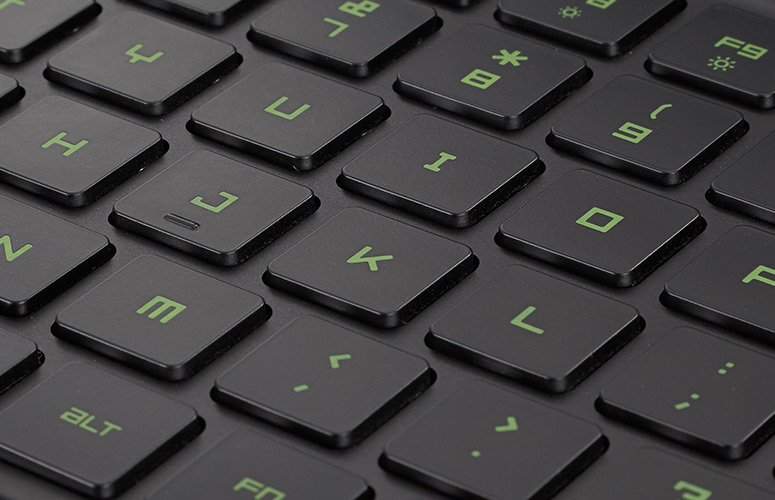
The keys are generously spaced, but in order to make room for the touchpad, the Space Bar, Backspace and Enter keys are slightly undersized
I was a little disappointed in the typing experience. Key travel was noticeably shallow at 1.3mm (1.5 - 2mm is optimal), but the 50-gram key actuation (force needed to depress a key) evened out the experience some. I scored 53 words per minute with a 3 percent error rate. That's worse than my usual 55 wpm/1 percent rate.
Touchpad
Without a doubt, the Blade Pro's most visually arresting feature is the LCD track panel with its 10 dynamic adaptive tactile keys.
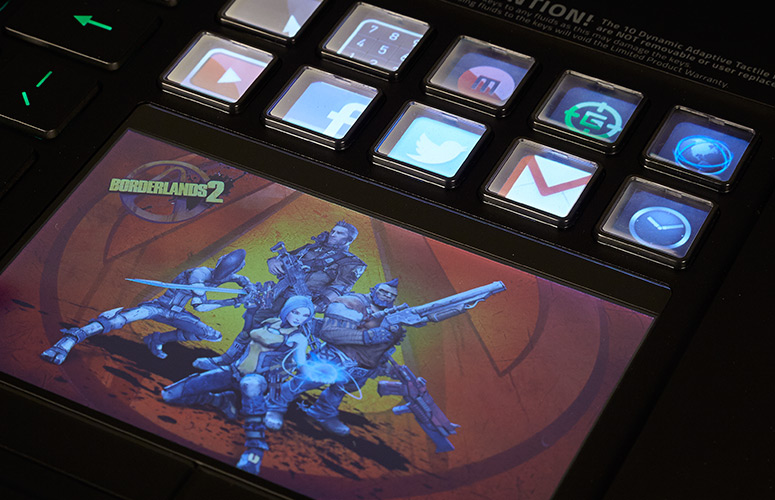
Unlike regular laptops, Razer has positioned the 3.5 x 2.1-inch touchpad to the right of the keyboard instead of below. The placement takes a lot of getting used to. I constantly found myself wearing a constant look of befuddlement as I swiped or tapped the traditional touchpad location below the keyboard only to realize I was futilely caressing empty space. Thankfully, the placement didn't make for awkward typing.
As a touchpad, the Synaptics panel offers zippy, accurate response, performing pinch-zoom, two-finger scroll and three-finger press with ease. The pad also provides seamless execution of Windows 8.1 gestures, including calling up the Charms menu or switching between recently opened apps.
Switchblade Interface
Serving as a second display, the Track Panel is more than a gussied-up touchpad. Used in tandem with the 10 dynamic adaptive tactile keys and unique Razer Switchblade interface, this 800 x 480-pixel color touch screen transforms into a highly useful and customizable piece of tech.
Before all the magic happens, you have to create a Razer account via the company's Synapse 2.0 software. Once the free account is set up, the keys blink to life with icons, including Gmail, Facebook, Gaming Mode, YouTube and Twitter.
In order to appeal to the creative professional crowd, Razer added shortcuts for apps such as Adobe Photoshop, Adobe Premier Pro and GIMP. Those interested in game or app design will welcome the Unreal Developer Kit (UDK) and Maya, 3D game development software. In case you dabble in audio production, you have the EDM-focused Afrojack Production Studio. The company hasn't abandoned gamers, adding shortcuts for Steam Chat, Virtual Joystick, TwitchTV and Trackpads for League of Legends, Counter-Strike, Battlefield 3 and Team Fortress 2.
Similar to the original interface, you can create up to 10 pages of shortcuts for the adaptive tactile buttons that can be cycled through with a quick three-finger swipe. Tapping the Razer button located next to the touchpad returns to the home screen.
So what does the interface look like when you activate one of the buttons? In the case of the YouTube shortcut, the adaptive tactile buttons donned YouTube-centric icons such as My Playlist, Browse, Subscriptions and Favorites. Watching video on the small 480p display was grainy, but passable.
When I launched GIMP, the touchpad took on an eerie green glow with the program's mascot. The buttons had turned into shortcuts that opened up multiple functions in the GIMP toolbox. For example, pressing the Pencil Tool icon let me access commands for the Paintbrush Tool, Bucket Fill Tool and Airbrush. While this is definitely cool, none of the commands will work unless you've already installed GIMP.
Synapse 2.0 Software
Razer's Synapse 2.0 cloud-based software is the backbone of many of its products. I couldn't help but smile when I logged into Synapse and saw my custom Borderlands 2 trackpad and shortcuts pop up on the track panel and adaptive tactile keys.
Creating profiles and macros are still very intuitive. For my Far Cry 4 profile, I grabbed a screenshot from one of my favorite scenes in the game for my trackpad wallpaper. After it was set, I went about creating a few macros to quickly switch out weapons, or access the map or my wingsuit.
Depending on how intricate your customizations are, expect to put in at least 10 to15 minutes prepping them. However, once that work is completed, you can save it to the cloud and access it from other Razer devices.
Heat
The Blade stays cool during routine task but gets hot under the collar while gaming. After streaming a Hulu video for 15 minutes, the LCD track panel registered 81 degrees Fahrenheit. The space between the G and H keys was 93 degrees -- just shy of our 95-degree comfort threshold. The black aluminum undercarriage was 90 degrees.

Things heated up though once I took the Blade Pro for a spin through the mountainous regions of Kyrat in Far Cry 4. After 15 minutes of gameplay, the space between the G and H keys registered 101 degrees and the bottom was a lap-warming 110 degrees. The touchpad was a cooler 87 degrees.
Webcam
Can I offer you a heaping helping of visual noise? The Blade Pro's 2-megapixel camera has plenty to spare. The test shot I took of me in office lighting looked very fuzzy. The camera did a better job on color, accurately capturing the richness of my orange sweater and the glowing garishness of my neon green headphones and blaster.
Ports
The Blade Pro takes a minimalist approach to ports, featuring a lone security lock on the right.
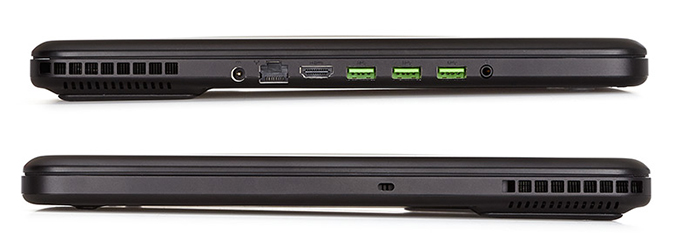
Located on the left are a trio of USB 3.0 ports, Gigabit Ethernet and jacks for a headset and power.
Gaming and Graphics
In terms of performance, the Razer Blade Pro's Nvidia GeForce GTX 860M GPU and 2GB of VRAM is on a par with most of the slim rigs on the market. When I played Far Cry 4, the laptop delivered a playable 30 fps on ultra-settings at 1080p. However, I saw significant tearing whenever I quickly spun around 360 degrees.
I saw improved rendering and experienced better movement when I dropped the settings down to very high, where the notebook achieved an average of 40 fps.
MORE: Top 25 Windows 8 Apps
The laptop notched 103 fps on the BioShock Infinite benchmark at 1080p on low. It's less than the 135 fps average, but much better than the Aorus X7's (Nvidia GeForce GTX 860M GPU) 89 fps. The Maingear Pulse 17, with its Nvidia GeForce GTX 870M GPU, fared better with 121 fps.
With the settings on high, the Blade Pro's frame rate dropped to 45 fps, missing the 61 fps average. The X7 notched 35 fps versus the Pulse 17's 52 fps.
The Blade Pro showed its mettle during the card-taxing Metro: Last Light tests, scoring 73 fps on low at 1080p. It's a couple of frames short of the 75 fps desktop replacement average, but the score is still better than the Aorus (68 fps) and the Maingear (70 fps).
The Blade Pro's frame rate took a significant hit on high settings, though, dropping to 17 fps, which is below the 23 fps average. It managed to edge out the Pulse 17's 14 fps, but not the X7's 22 fps.
Also crammed into the Blade Pro is an integrated Intel HD Graphics 4600 GPU to take care of the less-taxing activities.
Performance
Outfitted with a 2.4-GHz Intel Core i7-4700HQ processor with 16GB of RAM, the Razer Blade Pro is built for work as well as play. The laptop easily streamed an episode of Archer on Netflix while performing a system scan with 11 open tabs in Mozilla Firefox, Google Chrome and Internet Explorer.
The laptop scored 12,711 on Geekbench 3, which measures overall performance. It was just enough to beat the 12,266 desktop average. However, both the Maingear Pulse 17 (2.4-GHz Intel Core i7-4700HQ CPU) and the Aorus X7 (2.4-GHz Intel Core i7-4860HQ CPU) delivered higher results at 12,741 and 14,019, respectively.
The Blade Pro's 256GB SSD delivered a file transfer rate (duplicating 4.97GB mixed media files) of 145.4 MBps. That's less than half the 301.7MBps desktop replacement laptop average. The Pulse 17 and its dual 128GB SSDs produced a lightning-like 391 MBps, but the X7 (three 128GB SSD in RAID 0 configuration with 1TB hard drive) was the true speed demon with 565 MBps.
During the OpenOffice Spreadsheet Macro test (pairing 20,000 names and addresses), the Blade Pro and the Pulse 17 were neck and neck with times of 3:58 and 3:59, respectively. They outpaced the 4:45 category average, but not the X7 (3:47).
Battery Life
Gaming laptops aren't known for their battery life, no matter how slim and portable. The Razer Blade Pro, however, defied the odds and lasted 6 hours and 1 minute on the Laptop Mag Battery Test (continuous Web surfing over Wi-Fi).
MORE: 10 Laptops with the Longest Battery Life
This runtime absolutely shattered the 4:05 desktop replacement average. The Maingear Pulse 17 lasted a decent 5:15, but the Aorus X7 didn't even make it to 3 hours.
Software
Aside from all the fancy program shortcuts for the adaptive tactile keys, the Blade Pro has a sparse offering of apps. Razer-branded products include Synapse 2.0 and Comms, the company's free chat software. Outside of that, you have the usual Windows 8.1 offerings such as Calendar, OneNote, OneDrive, Skype and Weather.
Configurations
With Razer, you have to pay to play...or work. I reviewed the $2,399 configuration of the Razer Blade Pro, which has a 2.4-GHz Intel Core i7-4700HQ processor with 16GB of RAM, a 256GB SSD, a Nvidia GeForce GTX 860M GPU with 2GB of VRAM and an Intel HD Graphics 4600 GPU.
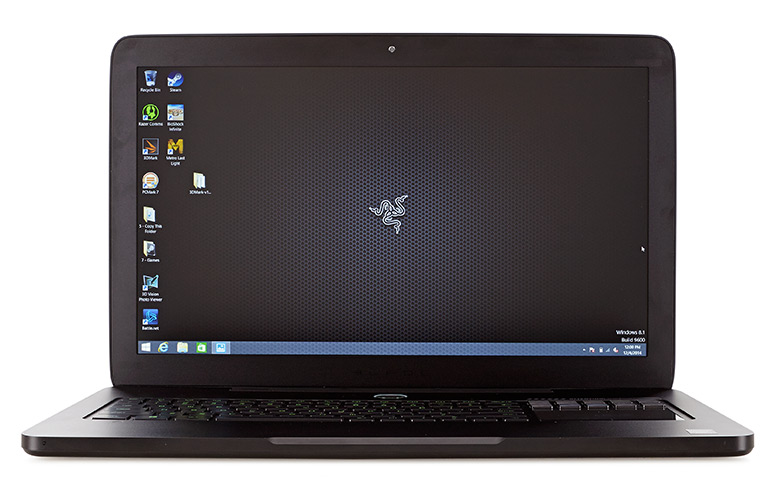
The base model is only nominally cheaper at $2,199. It has a similar configuration to my mid-level device with the exception of the smaller 128GB SSD. The 512GB SSD version will set you back $2,699.
Bottom Line
Razer wants laptop shoppers to have their cake and eat it, too. The latest iteration of the 17-inch Blade Pro appeals to fraggers and creative professionals alike. The new Nvidia GeForce GTX 860M GPU ensures that the Blade Pro can hang with its contemporaries when playing the latest titles while delivering strong video and photo-editing capabilities.
The star of the show continues to be the LCD touch panel, complete with adaptive tactile buttons and the Switchblade UI. The system delivers shortcuts on the fly for everything from your favorite games and GIMP to Photoshop and YouTube.
But for $2,399, the Blade Pro's display and audio quality could be better. The Maingear Pulse ($2,349) offers a sharper and brighter screen, excellent sound and better graphics performance.. Overall, though, the Blade Pro is a sound choice for gamers on the hunt for a slim and versatile 17-inch machine.
Razer Blade Pro (2014) Specs
| Bluetooth | Bluetooth 4.0 |
| Brand | Razer |
| CPU | 2.4-GHz Intel Core i7-4700HQ quad-core processor |
| Company Website | www.razerzone.com |
| Display Size | 17.3 |
| Graphics Card | Nvidia GeForce GTX 860M/Intel HD Graphics 4600 GPU |
| Hard Drive Size | 256GB |
| Hard Drive Speed | n/a |
| Hard Drive Type | SSD Drive |
| Native Resolution | 1920x1080 |
| Operating System | Windows 8.1 |
| Optical Drive | None |
| Optical Drive Speed | n/a |
| Ports (excluding USB) | USB 3.0, Headphone/Mic, HDMI, Gigabit Ethernet, DC-in |
| RAM | 16GB |
| Size | 16.8 x 10.9 x 0.88 inches |
| Touchpad Size | 3.5 x 2.1 inches |
| USB Ports | 3 |
| Video Memory | 2GB |
| Weight | 6.6 pounds |
| Wi-Fi | 802.11ac |
| Wi-Fi Model | Intel Wireless-AC 7260HMW |

Sherri L. Smith has been cranking out product reviews for Laptopmag.com since 2011. In that time, she's reviewed more than her share of laptops, tablets, smartphones and everything in between. The resident gamer and audio junkie, Sherri was previously a managing editor for Black Web 2.0 and contributed to BET.Com and Popgadget.
